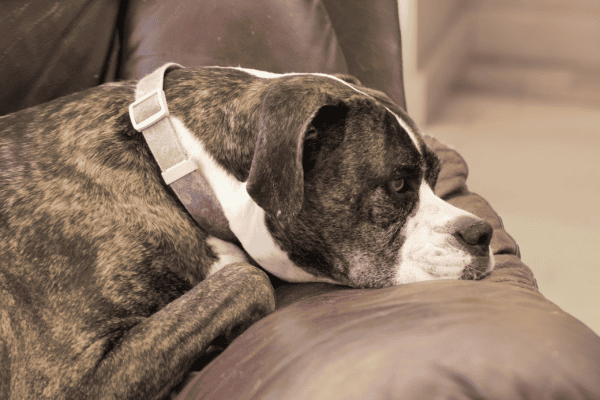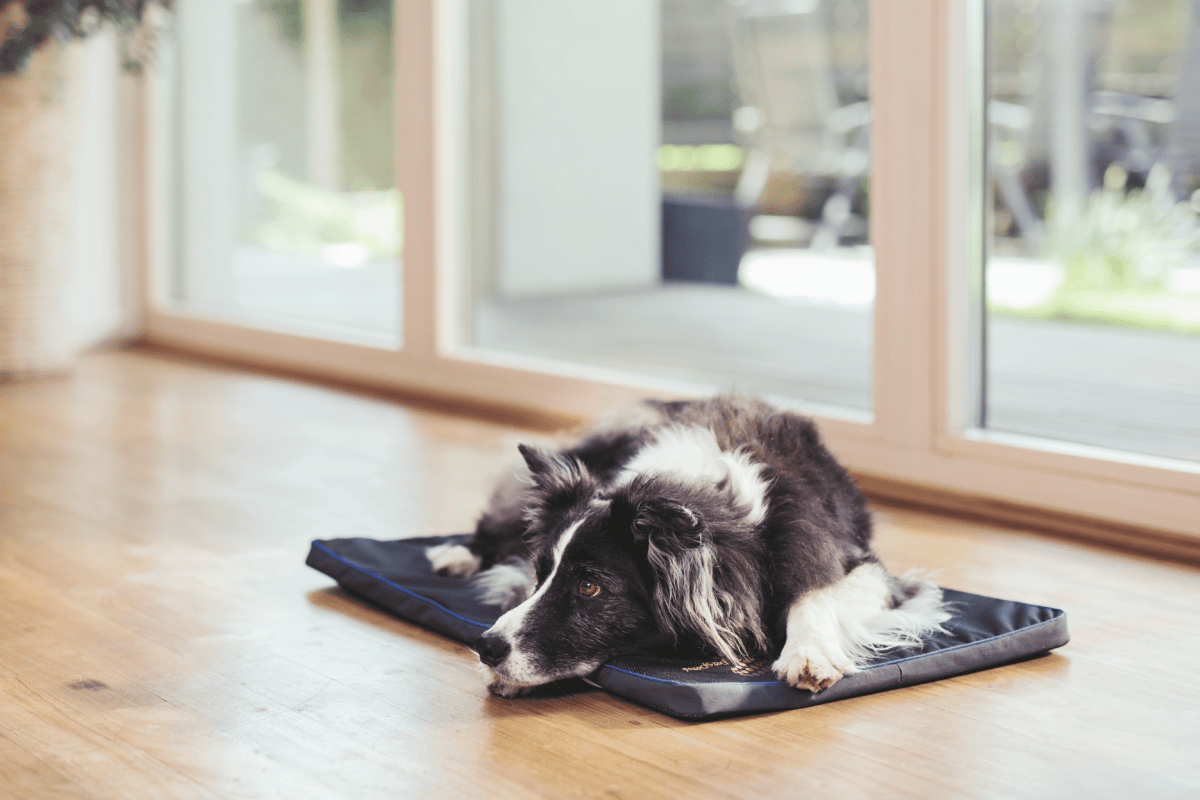Studies show that more than 70% of dogs exhibit anxiety-like behaviors. To make the statistics more concerning, canine anxiety is on the rise – today, more and more dogs are anxious due to different stress triggers.
Exciting research by Green Element (a CBD company) demonstrated that the number of dogs with separation anxiety jumped over 700% in the last two years, while anxiety caused by other pets spiked from 16.5% in 2020 to 43.52% in 2022.
But what exactly is anxiety in dogs, and how does it manifest? What can owners do to manage the situation? And, are there ways of preventing canine anxiety? Let’s find out.
What Is Anxiety in Dogs?
PetMD defines canine anxiety as the “anticipation of unknown or imagined future dangers.” Just like in humans, anxiety can be a normal emotion. However, if too accented, or frequently exhibited, dog anxiety is classified as a behavioral issue that has a negative impact on the dog’s quality of life.
Fear Vs. Anxiety Vs. Stress
Contrary to popular belief, fear, anxiety, and stress are not the same – they are similar and equally debilitating, but not the same. Here is a more detailed look at their definition according to the Glossary of Behavioral Terms by MSD:
- Fear: A graded response to the presence of a person, object, or social circumstance. The intensity of the response is proportional to the proximity of the trigger.
- Anxiety: Manifesting both physical and behavioral symptoms, anxiety is the fear of impending disaster or danger.
- Stress: It is a long-term state that can become a permanent problem and has consequences on both physical and mental health.
When it comes to dogs, anxiety is used as an umbrella term that includes all three of the above-explained feelings. Therefore, canine anxiety is used as the generic term.
What Causes Anxiety in Dogs?
There are many causes of anxiety in dogs – some are expected, and others are unusual. For example, some dogs are anxious when left alone, others when in the presence of unknown people, and there are dogs that get anxious during car rides.

Cause 1: Being Left Alone
Being away from the owner is one of the most common causes of anxiety in dogs. Sometimes, separation anxiety is the result of previous abandonments. It is more common in certain dog breeds such as German Shepherds, Toy Poodles, Labrador Retrievers, Jack Russel Terriers, Border Collies, Bichon Frises, etc.
Cause 2: Loud Noises
The fear of loud noises is termed noise anxiety and is a common issue. It can be triggered by any loud noise, including thunders, fireworks, construction work, traffic, sirens, and house appliances (vacuum cleaners, washing machines).
Cause 3: Social Situations
Social situations can trigger anxiety in unsocialized dogs. Dogs that have not spent time around new people/pets and in new situations when pups lack socialization. Dogs with social anxiety can act either scared or aggressive.
Cause 4: Past Trauma
Past trauma is a common cause of anxiety in dogs. It can stem from being left in a shelter, abandoned, or physically abused. Dogs with this type of anxiety show general unease and need predictability and routine to thrive and feel safe.
Cause 5: Age
In older dogs, anxiety is often triggered by age-specific health conditions such as cognitive dysfunction syndrome (CDS). Cognitive dysfunction syndrome is the canine equivalent of Alzheimer’s disease in humans. CDS is common in dogs over 11 years of age.
Cause 6: Medical Conditions
Even medical conditions can cause anxiety in dogs. The list of health conditions that can result in canine anxiety includes hormonal imbalances (hypothyroidism, diabetes), declining senses (hearing loss, vision loss), and brain inflammation (encephalitis).
Finally, the cause of anxiety can be unknown. In such cases, we use the term generalized anxiety. Dog breeds prone to this type of canine anxiety are Border Collie, Vizsla, Cocker Spaniel, Labrador Retriever, German Shepherd, Australian Shepherd, Greyhound, King Charles Spaniel, and many toy breeds.
What Are The Signs of Anxiety in Dogs?
When it comes to anxiety in dogs, there is no standard behavior – some dogs retreat and act scared, while others become destructive and aggressive.
Here are some of the most common signs of anxiety in dogs:
- Excess salivation (drooling)
- Panting (fast breathing)
- Trembling or shaking
- Destructive behavior
- Unreasonable barking
- Scanning or attentiveness
- Increased vigilance
- Pacing or restlessness
- Compulsive/repetitive behavior
- Urinating/defecating in the house
- Unprovoked aggression
- Depression and lethargy
- Refusal to eat
- Disrupted sleeping patterns
- Body language changes.
How To Treat Anxiety in Dogs?
As a complex issue, anxiety in dogs requires a multimodal approach – combining different methods. Also, every dog is different, and finding the right anti-anxiety combination often entails a trial and error phase.
Treatment Option 1: Mental & Physical Stimulation
Both physical and mental stimulation are great for managing anxiety in dogs. An anxious dog has excess energy, and exercising the body and mind helps channel that energy into something productive.
In terms of physical exercise, you can take your dog to the dog park or go for a run or hike. Alternatively, if it prefers mental stimulation, play interactive games or buy your dog puzzle toys.
Treatment Option 2: Physical Contact
The anti-anxiety effects of physical contact are greatly underrated. Studies show that physical contact results in release of oxytocin which in turn has a calming effect.
So, the next time your dog feels anxious, try physical contact – petting or cuddling. Alternatively, you can make an even better use of the contact by giving your dog a relaxing massage.

Treatment Option 3: Music Therapy
Music therapy is another excellent option for calming anxious dogs. Studies show that classical music has a calming effect on dogs in stressful situations. Another study showed that jazz music lowers the dog’s heart rate (which is linked with relaxation), while rap and rock music increase the heart rate.
Treatment Option 4: Calming Supplements
Calming supplements for dogs are effective and safe (most are made with natural ingredients). Usually, they contain melatonin, chamomile, passion flower, L-theanine, L-tryptophan, valerian root, or thiamine (vitamin B1).
At the moment, one of the most popular calming supplements for dogs is CBD oil. Studies show that supplementing dogs with cannabidiol results in decreased anxiety-related behaviors. Plus, dog CBD supplements come in different forms – from oils to chews to peanut butter.
Treatment Option 5: Dog-Appeasing Pheromone
Dog appeasing pheromone (DAP) or apasine is a mix of chemicals produced in the sebaceous glands of lactating female dogs. The chemicals are, in fact, esters of fatty acids and have a calming effect.
Studies show that DAP is efficient and positively impacts anxiety-related signs such as anorexia, vigilance, shaking, pacing, vocalization, and destructiveness. Today, there are DAP products in the form of sprays, collars, and diffusers.
Treatment Option 6: Anti-Anxiety Crates & Beds
Anti-anxiety crates and beds can also be used to manage stressed dogs. Crates are often misunderstood, but when used correctly, they calm dogs and give them a sense of security. Beds help relieve pressure, thus supporting calmness and relaxation.
Treatment Option 6: Anti-Anxiety Crates & Beds
Anti-anxiety crates and beds can also be used to manage stressed dogs. Crates are often misunderstood, but when used correctly, they calm dogs and give them a sense of security. Beds help relieve pressure, thus supporting calmness and relaxation.
Treatment Option 7: PEMF Therapy
PEMF therapy is a relatively novel approach in veterinary medicine, but so far, it has found several applications. Human studies and lab animal studies have shown that PEMF therapy works for managing anxiety, and the same results can be expected in dogs.
PEMF therapy is painless, affordable, and easy to implement. Plus, it is a great alternative to mainstream anti-anxiety drugs and can be used as part of a multimodal plan. PEMF is contraindicated in pregnant bitches, cancer patients, and dogs with pacemakers.

Treatment Option 9: Thundershirts
Another tool worth trying is the calming coat, vest, or t-shirt. This dog apparel works by applying constant pressure on the body (similar to swaddling cloths on babies). Studies show that anxiety vests decrease overall anxiety scores. They can be used in dogs with separation, noise, strangers, and travel anxiety.
Treatment Option 9: Behavior Modification
Behavior modification is a specific approach that includes several techniques and usually entails the help of a professional canine behaviorist. Counterconditioning and desensitization are the most common techniques.
Counterconditioning focuses on changing the dog’s perception of the stressor or trigger (by linking it to a pleasant experience). Desensitization includes exposing the dog to low-level stressors to achieve resistance. Both techniques are great for managing anxiety, but their success takes time.
Treatment Option 10: Anxiety Medications
Anxiety medications are usually reserved for dogs that do not respond to other forms of anxiety treatment. Most anxiety meds require a veterinary prescription, and even if available over-the-counter, it is best to consult with a vet before use.
Some of the most commonly used anxiety meds for dogs are Diphenhydramine (Benadryl®), Alprazolam (Xanax®), Lorazepam (Ativan®), Sertraline (Zoloft®), Dexmedetomidine (Sileo®), Diazepam (Valium®), Clomipramine (Anafranil®), Trazodone (Desyrel®), Fluoxetine (Prozac®), Buspirone (BuSpar®), etc.
In Conclusion: The Impact of Anxiety in Dogs on Overall Health
Just like people, dogs can suffer from anxiety. Canine anxiety is an emotionally challenging state that has a negative impact on the dog’s overall well-being. Sadly, anxiety in dogs is often misunderstood or overlooked.
According to a study by Guide Dogs, only 36% of dog owners can detect the signs of poor mental health in their pets. Also, 24% of dog owners were not even aware that poor mental health in dogs is possible.
With that being said, it should be our mission to raise awareness about anxiety in dogs and help pet owners around the world recognize its signs and take proper action to manage the situation and provide stress relief.
References:
• Salonen M, Sulkama S, Mikkola S, Puurunen J, Hakanen E, Tiira K, Araujo C, Lohi H. Prevalence, comorbidity, and breed differences in canine anxiety in 13,700 Finnish pet dogs. Nature, 2020 March
• Green Element CBD. Study: Prevalence of Pet Anxiety in the US, 2022
• Landsberg GM. Glossary of Behavioral Terms. 2016 June
• Beetz A, Kerstin UM, Julius H, Kotrxchal K. Psychosocial and Psychophysiological Effects of Human-Animal Interactions: The Possible Role of Oxytocin. Front Psychol. 2012; 3: 234.
• Lindig AM, McGreevy PD, Crean AJ. Musical Dogs: A Review of the Influence of Auditory Enrichment on Canine Health and Behavior. Animals 2020 Jan; 10(1): 127.
• Aubin B, Balduf O, Lambert A. Music’s Effect on Dogs’ Heart Rates. Journal of Emerging Investigators. 2017 October
• ElleVet Sciences. The Use of ElleVet Sciences Calm and Comfort Acute Strength CBD+CBDA Chews for Anxiety Inducing Events in Dogs. 2020
• Kim YM, Lee JK, Abd AM, Hwang SH, Lee JH, Lee SM. Efficacy of dog-appeasing pheromone (DAP) for ameliorating separation-related behavioral signs in hospitalized dogs. Can Vet J. 2010 Apr; 51(4): 380–384.
• Gaynor JS, Hagberg S, Gurfein TB. Veterinary applications of pulsed electromagnetic field therapy. Volume 119, August 2018, Pages 1-8
• Pawluk W. Pulsed Magnetic Field Treatment of Anxiety, Panic and Post Traumatic Stress Disorders. J Altern Complement Integr Med. 2019, 5: 075
• Semenova TP, Medvinskaia NI, Bliskovka GI, Akoev IG. Influence of electromagnetic fields on the emotional behaviour of rats. Radiats Biol Radioecol. 2000 Nov-Dec;40(6):693-5.
• Fish RE, Foster ML, Grien ME, Sherman BL, Dorman DC. Effect of Wearing a Telemetry Jacket on Behavioral and Physiologic Parameters of Dogs in the Open Field Test. J Am Assoc Lab Anim Sci. 2017 Jul; 56(4): 382–389.
• Guide Dogs. Guide Dogs Encourages Enrichment to Boost Dog Mental Health. 2022 March

